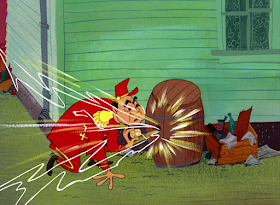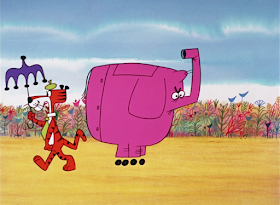In the 1960s, television was a big part of life. Television was full of commercials, with admirable announcers who were heard year after year after year. They were anonymous, unless they showed up elsewhere and got a credit; Alexander Scourby comes to mind (among many things, he was the narrator for National Geographic specials, for which he got screen credit).
There were two announcers I heard all the time back then. Their voices were instantly recognisable but for years I had no idea who they were. It was only by stumbling onto industrial films that I learned their names. One was Norman Rose who, I recently discovered, narrated all kinds of children’s records. The other was Peter Thomas.
Thomas was amazing. Or extremely fortunate. Or both. Age changes one’s voice—it did mine—and not always for the better. Thomas was still doing narration at age 90 and sounded the same as he did half a century earlier.
There is a great, almost-one-hour interview with him on the internet. He had an incredible career, starting in his home-town of Pensacola, Florida before he enlisted for war service. The local paper, on October 27, 1940, wrote: “Cub announcer, Peter Thomas, has been added to WCOA’s staff.” The same paper enlightened readers with short biographical sketches of station announcers on June 8, 1941: “PETER THOMAS—Born in Pensacola; is 18 years old; started in radio as an actor on dramatic shows over WCOA; later hired as junior announcer at WCOA; recently promoted to regular commercial announcer; will carry afternoon and late night shift; weight, 135, tall, has a decided English accent.” It left out his starring role as “Dick Denny, American Birdman.”
The paper announced, on August 17, 1941, Peter’s departure from the station to New York. He moved there to attend Stony Brook. Then came the war. Then came television. His early experiences did not include the sombre narration he would become known for. Anything but. His attitude was like Henry Morgan’s at times. The Memphis Press-Scimitar of April 10, 1950 picks up the story.
‘Unhandy Handy’ Peter Thomas, Video Star, Has a Big Role
By ROBERT JOHNSON, Press-Scimitar Staff Writer
Peter Thomas is the sort of fellow who if there is a crack in the sidewalk he will trip on it. Things just naturally happen to Peter. If an accident is waiting around for somebody to happen to, Peter will show up.
It was, perhaps, a bit of an accident that he has become probably the major local personality developed by television since WMCT went on the air. But that engaging, ingenuous personality which has maintained his popularity is all Peter's. There's something encouraging to the average spectator in watching anyone as buffeted by fate as Peter stumble thru adversity like Dagwood Bumstead triumphantly catching a bus.
Peter will be the professor in the college division of "School Days." It is to be hoped that the stage does not collapse.
Son of Minister
WMCT's "Unhandy Handy Man" is the son of English parents. His father, a Presbyterian minister in Pensacola, is an Oxford graduate. Peter, who is only 26 now, began doing juvenile dramatic parts on a Pensacola station when he was 15, began announcing and took over the night shift in 1939.
He entered the Army in 1943, went right on from the invasion thru France, Belgium, Holland and into Germany with the First Infantry Division.
"I made private first class during the Battle of the Bulge," he said.
He was a rifleman, later became a division MP. During the Battle of the Bulge he got a piece of shrapnel in his leg. "It wasn't much," he said, "but it got me a Purple Heart."
 After the war, he worked with a Mobile station a year.
After the war, he worked with a Mobile station a year. Charley Sullivan, WMC's chief announcer, is from Pensacola and an old friend of Peter's. When there was an opening, he arranged a chance on WMC's staff for Peter.
It was entirely chance that Peter became the Unhandy Handy Man. Henry Slavick, the station manager, had seen a program introducing new gadgets on a New York television station. He wanted something like it.
"I just happened to be the announcer on duty that night," Peter explains. The program was called "What's New."
Flustered Demonstration
Peter demonstrated a cheese cutter, a three-piece device. It fell apart on him and he couldn't get it back together. He showed a toy fire truck, activated by pressing a lever. The engine just wouldn't move.
"I got so flustered I didn't know what to do," Peter said. But he kept trying—desperately, and he talked while he tried.
Slavick, watching at home, was devastated. But then the letters and phone calls began coming in. People liked Pete's friendly clumsiness.
"I'm not a comedian," Peter says.
"I'm just not a fixer. I'm no good at all around the house.
"In the Army I always messed up inspection. One time I pulled a grenade pin and I don't know what would have happened if somebody hadn't yelled at me to get rid of it."
Peter began to get sponsors. It didn't matter that he stopped right in the middle of a commercial and muttered—"That's all he paid for." One of his sponsors is Collins & Freeman. Peter referred to Frank Freeman once as "an old goat—but he needs your business." Mr. Freeman loved it, gleefully paid one of his salesmen to let Peter demonstrate a home hair clipper on him. The clipper slipped, and a wide furrow was cut across the subject's tonsure.
Got 'Em Mystified
Right now, says Eddie Frame, WMCT's public relations man, Peter has sponsors backed up for two months. Rhea Smith, who conducts the "What's Cooking" show, says around the station they're always wondering whether to compliment Peter on some piece of business. "We never know whether he planned it or whether it just happened," she said.
He began to get well known. A cop stopped him for speeding, smiled up, 'Hello, Uncle Pete," calling him by the name the children use on "Steps to Stardom."
Two ladies watched him while he was shopping at Lowenstein's. "We're waiting for him to break something," one explained.
Peter and his wife, a Pensacola girl, live at 1927 S. Parkway E. They have a daughter, Stella Elizabeth, one-and-a-half.
"My wife lets me hold the baby," Peter said. That, playing tennis and writing short stories are his major diversions. He has never yet dropped the baby.
Thomas dropped something that year—his job in Memphis. A CBS handout found in Ohio’s Sidney Daily News of Oct. 16, 1954 reported his work in the Tennessee city had financed his education at Memphis State College and Southwestern University. He was then off for New York to record poetry on a series of syndicated programmes for the Hamilton Watch company and won an audition at CBS in 1951. Among his early assignments was announcing Faye Emerson’s TV show. The release sent to newspapers was to publicise he had replaced Dan Seymour as the announcer on the Aunt Jenny radio show (a favourite target of Bob and Ray).
The Pensacola News Journal of May 5, 1957 wrote of some of his network credits.
VOICE OF MELODY
 The voice of CBS radio's late evening musical presentation, "Melody in the Night," is one of the top announcers in the radio field. He has been with CBS for nearly six years as a staff announcer and actor, going to CBS in 1950 from WMC-WMCT in Memphis, Tenn. Prior to that assignment, Thomas was an announcer for a year at WALA in Mobile.[...]
The voice of CBS radio's late evening musical presentation, "Melody in the Night," is one of the top announcers in the radio field. He has been with CBS for nearly six years as a staff announcer and actor, going to CBS in 1950 from WMC-WMCT in Memphis, Tenn. Prior to that assignment, Thomas was an announcer for a year at WALA in Mobile.[...]Since joining CBS Thomas has handled a number of choice assignments including "Theater of Today," "Young Doctor Malone" plus television announcing jobs on "News on New York" and the "Good Morning Show."
He has handled radio, TV and film assignments for more than 49 advertisers and has done cutting for news broadcasts during his career in broadcasting. Thomas assumed his duties as the "voice" of "Melody in the Night" on Nov. 5, 1956.
It would be impossible to name every company that employed him. You can start with IBM, Exxon and American Express. He narrated all 403 episodes of Forensic Files. He won an Oscar for the HBO documentary One Survivor Remembers. You heard him on episodes of Nova. He was an image voice for cable channels. His hometown newspaper obituary mentioned a wry piece of copy he read for another client: “Sadly, every year, millions of innocent cakes are mangled, mistreated and hurt, but there is something you can do. Go to the freezer section of pick up new Cool Whip topping.”
He was 91 when he died on April 30, 2016
There are likely readers who are not quite sure who I am talking about. Below is one of his many, many commercials. Surely you’ll know the voice.
And he appears on camera in this 1972 industrial film.




















































